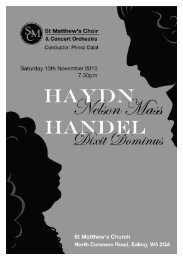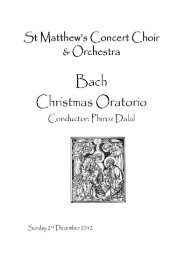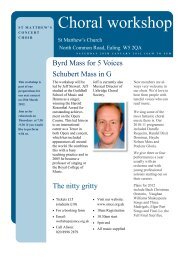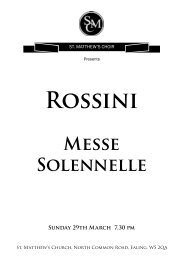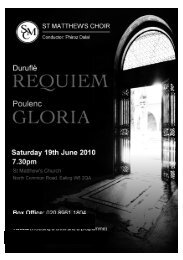25th March programme - St Matthew's Choir
25th March programme - St Matthew's Choir
25th March programme - St Matthew's Choir
Create successful ePaper yourself
Turn your PDF publications into a flip-book with our unique Google optimized e-Paper software.
Thanks to<br />
Rehearsal accompanist: Ken Williams<br />
Tech crew manager: Dave Benny<br />
Video director: Dawn Slaughter & Alistair Slaughter<br />
Video engineer: Damien Giromella<br />
Audio engineer: Ron Keefe<br />
Cameras: Eleanor Britton, Kane Ray, and Zubin Dalal, Ali<br />
Smith and Alistair Slaughter<br />
FOH manager: Jenny Shepherd<br />
Door Margaret and Roy Burton<br />
Bar Mary Zajdler and Jane Salisbury<br />
Box office: Molly Thomas<br />
<strong>St</strong> Matthew’s Concert <strong>Choir</strong><br />
Musical Director: Phiroz Dalal<br />
Sunday <strong>25th</strong> <strong>March</strong> 2012<br />
ST MATTHEW’S CHURCH<br />
The vicar and congregation of <strong>St</strong> Matthew’s Church<br />
NEXT CONCERT<br />
Sunday 1st July 2012 7.30pm<br />
Howard Goodall Eternal Light: A Requiem<br />
Finzi Lo the full final sacrifice<br />
Sing and be inspired!<br />
We welcome new singers. Ideally you can read music<br />
and sight-read a simple line. You’ve probably sung on<br />
and off all your life.<br />
Term dates: 12th April to 5th July<br />
7.30pm to 9.30pm<br />
MOZART Venite Populi<br />
SCHUBERT Mass in G<br />
GIBBONS O Clap your hands<br />
BYRD Mass for Five Voices
Wolfgang Amadeus Mozart (1756-1791)<br />
Venite Populi (1776)<br />
Accompanist: Ken Williams<br />
The sacramental offertory Venite Populi was composed<br />
for an Ascension Day service in 1776, and is a rare<br />
example of Mozart’s writing for double chorus. It features<br />
several stylistic traits dating back to the Italian Baroque<br />
including antiphonal echo effects & highly contrasted<br />
rapid-fire counterpoint tossed back and forth<br />
between the two choruses.<br />
Franz Schubert (1797-1828)<br />
Mass No. 2 in G (1815)<br />
Accompanist: Ken Williams<br />
Soprano: Helen Dawson<br />
Tenor: Colin Smith<br />
Baritone: Gareth Bevan<br />
Schubert wrote this simple but charming setting of the<br />
Mass in 1815 for his local church in Liechtenthal, a<br />
suburb of Vienna. He was just 18 years old. This youthful<br />
work is a fine example of Schubert's lyrical skill, heard to<br />
particularly fine effect in the Kyrie and Benedictus. The<br />
setting owes its formal plan to Mozart's and Haydn's short<br />
Viennese Masses, especially in the Sanctus where a<br />
weighty opening section is followed by a lively, vigorous<br />
fugue. The Gloria, too, displays a contrast of mood but<br />
here a lyrical central section is framed by music of great<br />
fire. The Credo opens and closes quietly with<br />
the Crucifixus section providing a more forceful episode.<br />
The Agnus Dei, with its choral pleas interspersing the<br />
soloists' phrases, brings the work to a peaceful<br />
conclusion. This author of this <strong>programme</strong> note is unknown it was<br />
supplied through Making Music's <strong>programme</strong> note service.<br />
Orlando Gibbons (1583-1625)<br />
O Clap your hands (1622)<br />
Gibbons was Organist of the Chapel Royal and a Doctor<br />
of Music of the University of Oxford but is best known as<br />
Organist of Westminster Abbey from 1623. He was<br />
among the finest of the English composers of the<br />
Renaissance Period and came from a large family of<br />
musicians none of whom achieved the high level of<br />
notoriety achieved by Orlando. O clap your hands dates<br />
from 1622 and is written in eight parts, it is a dramatic<br />
and majestic setting of Psalm 47 and is one of the most<br />
impressive anthems of a composer noted for his Anglican<br />
church compositions.<br />
Willliam Byrd (1543-1623)<br />
Mass for 5 Voices (1590s)<br />
The five-part Mass was written in the 1590s. Byrd is<br />
known to have been a tenaciously loyal Catholic in a<br />
country which was more or less militantly Protestant. He<br />
could have been sent to the stake for his beliefs. It took<br />
some courage, therefore, to set & publish Latin texts at<br />
all at that time. Byrd published three Mass-settings<br />
between c.1593 and c.1595 separately, in very small<br />
books and without any title-pages. The music itself is<br />
deeply expressive. Its emotional range extends from a<br />
darkness which is almost hopeless - in the fourpart<br />
Agnus Dei - to a fierce defiance in adversity at 'Et<br />
resurrexit' in the five-part Credo. During the course of<br />
these pieces Byrd clearly explored every feeling a man<br />
may have when he is fighting for something he<br />
passionately believes in, with his back to the wall.



